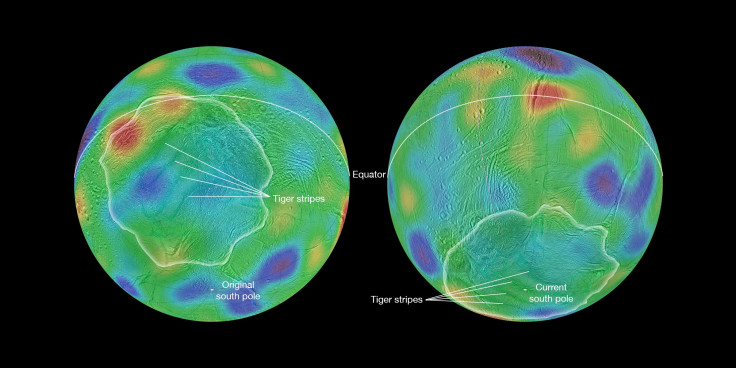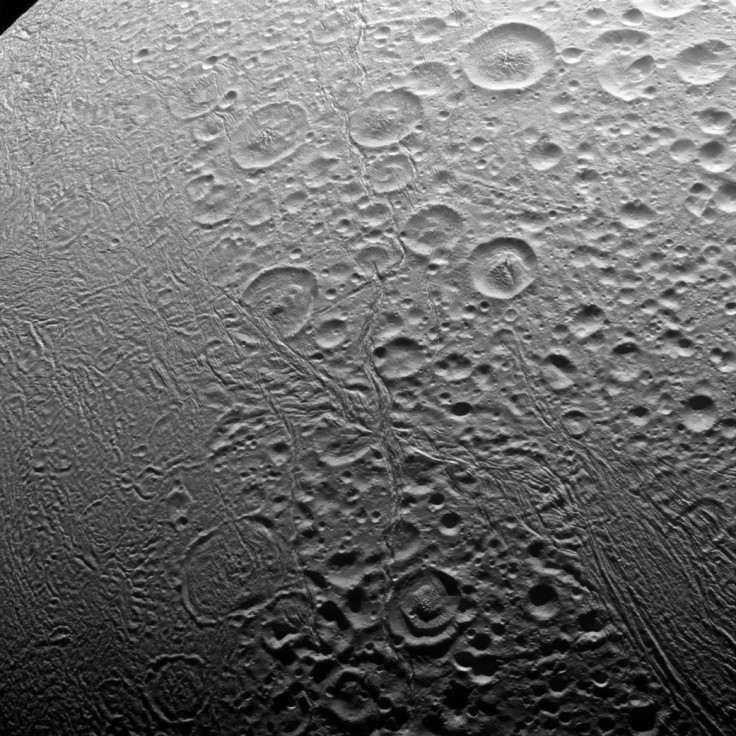NASA’s Cassini Finds Saturn’s Icy Moon Enceladus May Have Tipped Over, Probably Due To Asteroid Collision

The south polar region of Saturn’s icy moon Enceladus is of great interest to scientists, given its geological activity which includes jets of water vapor and icy particles being sprayed out into space. However, the region that now forms the south pole, with its famous “tiger stripes” could have once been near the moon’s equator, according to data captured by Cassini.
The NASA spacecraft, which has been observing the Saturn system, including the planet, its rings and over 60 known natural satellites, since 2004, made an examination of some of the moon’s features. Based on that, it “found evidence that the moon’s [Enceladus] spin axis — the line through the north and south poles — has reoriented, possibly due to a collision with a smaller body, such as an asteroid,” according to a statement Wednesday by NASA.
“We found a chain of low areas, or basins, that trace a belt across the moon’s surface that we believe are the fossil remnants of an earlier, previous equator and poles,” Radwan Tajeddine, a Cassini imaging team associate at Cornell University in Ithaca, New York, and lead author of a recent paper on the subject, said in the statement.
Read: Cassini Observes Summer Solstice On Saturn
The tiger stripes on Enceladus’ south polar region are fractures that are a testament to the heat source beneath the moon’s icy surface, and were discovered by Cassini in 2005. According to the paper’s authors, that region may have been struck by an asteroid when it was closer to the equator sometime in the past. That collision probably caused a change of about 55 degrees in the moon’s polar axis.

“The geological activity in this terrain is unlikely to have been initiated by internal processes. We think that, in order to drive such a large reorientation of the moon, it's possible that an impact was behind the formation of this anomalous terrain,” Tajeddine said.
The disruption caused to Enceladus by the likely impact, and the creation of the tiger stripes, led to redistribution of some of the moon’s mass, and affected its rotation too, making it wobbly and unsteady, the authors speculate. As the rotation stabilized over a long time, possibly over one million years, the north-south axis of the moon reoriented and passed through different points on the surface, in a process called “true polar wander.”

This idea could also explain the vastly different behavior observed on the present-day north and south poles of Enceladus. The former appears to be relatively older and is covered in craters, and the latter is geologically active and younger.
The Cassini spacecraft is a part of the Cassini-Huygens mission that was launched in October 1997. Huygens was a probe built by the European Space Agency that successfully landed on the surface of Saturn’s largest moon, Titan, in January 2005, 20 days after it separated from Cassini. It is the most distant landing achieved by humans so far, and the only one successfully made in the outer solar system. The mission itself was a collaboration between NASA, ESA and the Italian space agency.
Cassini is currently in its Grand Finale mission, which involved a series of dives through the rings of Saturn. After the last of the dives in September, the spacecraft will fall to its death into Saturn’s atmosphere, a maneuvrer designed to ensure no contamination occurs on any of the planet’s moons, some of which are potentially habitable.
© Copyright IBTimes 2025. All rights reserved.





















